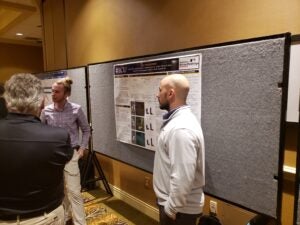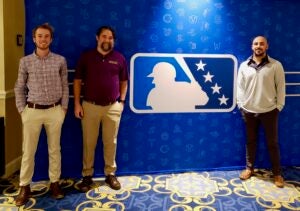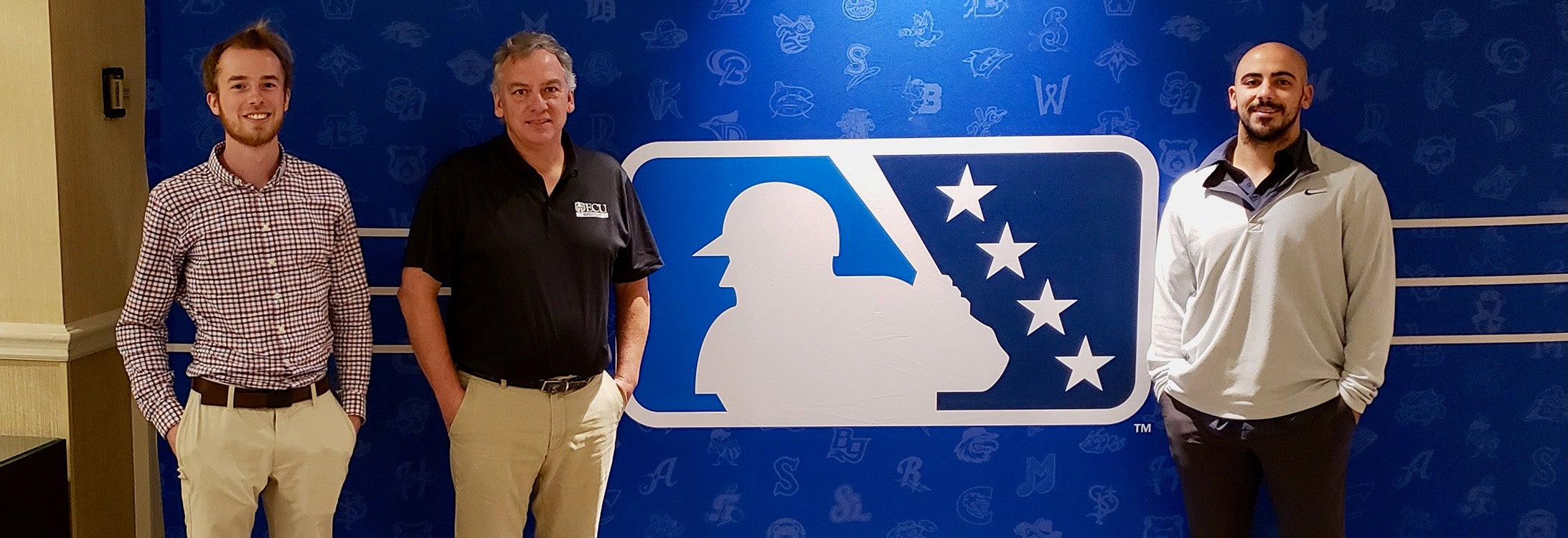Student/alum spotlight from MLB Winter Meetings
The Major League Baseball Winter Meetings is an annual marquee event in the professional baseball offseason calendar. The 2023 version was held in December in Nashville, Tennessee, in conjunction with a new event about baseball biomechanics, in which research out of East Carolina University’s Visual Motor Lab and Performance Optimization Lab and collaborative work by graduate student Taylor Kinney, College of Health and Human Performance alum Jake Kuchmaner, Drs. Nick Murray and Zac Domire, and Patrick Rider, the Department of Kinesiology’s director of applied sport science, was selected to showcase. Kinney and Kuchmaner presented during a thematic poster session — “Just Throw Strikes!” which focuses on quiet eye during pitching related to anxiety and performance — with support from Domire (Performance Optimization Lab director) and Murray (director of the Visual Motor Lab) also in attendance at the high-profile winter meetings.
“The American Baseball Biomechanics Society organized this and there had been discussions of trying to have some meeting in conjunction with the winter meetings, but this was the first time it actually happened,” Domire said. “Nobody knew really what to expect. … It was quite selective to actually be there and their presentation was really good. It was clever the way they set it up in the way they divided up the work worked very well.”
The following is a Q&A transcript from a recent sit-down with Kuchmaner, a 2023 Master of Science graduate in Kinesiology with a concentration in sport and exercise psychology, and Kinney, a current doctoral student in bioenergetics and exercise science with a concentration in biomechanics and motor control:
Q: What is the bullet-point version or easiest way to describe eye-tracking glasses and this research?
TK: To summarize it in a sentence and the biggest takeaways we found is if a pitcher is able to quiet their eye and fixate on a specific point, they seem to be better at handling anxiety and also performing to a better degree.
JK: It definitely is an eye thing, like being able to hold your gaze steady, but it’s also a reflection of how well they can hold their attention. So it’s being able to hold your attention at the right time helps, and taking what Taylor said that it helps you perform when there’s pressure and helps increase your performance as well.

Jake Kuchmaner, right, and Taylor Kinney chat with team representatives during MLB Winter Meetings.
Q: How did you prepare for your presentation?
TK: We sat maybe an hour before and went over what I was going to say and what Jake was going to say. We wanted to run through it and make sure we were comfortable and good, knowing this was Jake’s thesis.
JK: I spent probably two years immersed in this, fully, so I thought I had a good grasp on it and obviously had to revisit it. It’s like riding a bike and you just get back into the verbiage a little bit and most of the time we spent preparing was just on the efficiency of what we were trying to say and being quick. We could have spent 2 hours on this topic and felt like we still didn’t cover everything we needed to cover.
Q: Jake, you played baseball at ECU, including pitching the first perfect game (retiring all 27 opposing batters in order) in ECU history March 17, 2019, at Maryland. How has research impacted your perspective as a baseball player?
JK: To be on the other side of it, especially at these meetings, was really cool. It gave me a better appreciation of the sports science side of things. As a player, you are always trying to find whatever methods work and what doesn’t work. I was humbled very fast at how hard it is to find significant training methods, so I definitely have grown an appreciation for sports science. It can really change a player’s path or a team’s path, if used correctly.
Q: Can you describe a memorable conversation from the meetings?
TK: After we presented, the moderator of the event introduced me to one of his good friends, who pitched in the 1985 World Series for the Kansas City Royals. He was there in more of a commercial role on product design. I got to talk to him about where we could see this going in a product development sort of way, not just from a pure scientific way, but also from a commercialization standpoint. That was pretty fascinating and is something that will probably stick with me. His big thing was just making sure we keep it as simple as possible. Obviously big research is going to be important when you’re talking to funders and what not, but also being able to relate it in a more concise manner and being able to relay this in a quick, easy manner.
Q: How did you get introduced to this work?
JK: When getting introduced to all of the different paths you can take and the (HHP) labs, I remember seeing Dr. Murray’s eye research and how it was done in baseball. I emailed him, we met and we talked it through and took it from there. I think, especially with this topic, there is an intuition with that. Everyone kind of knows it’s there, you just need some numbers behind it to explain it.
TK: When I was in my undergrad at Indiana State University, I always kind of knew sports was an option for me going into the exercise science realm. I got introduced to a biomechanist mentor and learned this is kind of an emerging field and you can take it and really run with it. I started my master’s at the University of Nebraska Omaha, and we established a biomechanics pitching lab. There was only three in the nation, at the time, to have one of these labs. So through that, I was able to gain the knowledge, from the biomechanical side, and always kind of knew about ECU and what Dr. Murray and Dr. Domire were doing. When I was reaching out about a PhD, I was told about what Jake was doing and I thought this makes a lot of sense with what I’m doing already with biomechanics. I came over to help Jake with his thesis project and have since switched gears a little but, but am still doing eye-tracking and doing it more in a soccer frame of reference.
Q: What do you think is next for this research and applications?
TK: What we would really like to do with this specific research is to develop a standardized way of collecting eye-tracking research for baseball pitching. It’s been done in basketball and table tennis and a lot of sports, but nobody has really approached standardized eye-tracking in pitching. With this data, we hope to put out a preliminary paper that shows eye-tracking. It is kind of intuitive that you really need to look at something to throw a baseball to an exact spot, but nobody has really formalized that. We want to be the first ones to show numbers to back this up. I think validating this approach is the first step, and then adding in that pressure piece is a next step. Hopefully we get another graduate student who is interested in this project, because I think the sky is the limit with what we’ve found here.
Q: Jake, you also provide pitching lessons locally at Next Level Training Center (where the eye-tracking research was conducted). Do you use this research in pitching lessons?
JK: It’s definitely a teaching point, and is something I work on myself. When I’m working with kids now and especially the younger guys, we have to make sure they are looking at the target before they lift their leg or at some point. It’s a pretty good indication of whether or not a kid can consistently throw a strike. I see it all the time that they will kind of lift and their head is going everywhere and they try to get it back and they are spraying balls (not consistently in the strike zone). I think it is immediate in that you can use it right away.
Q: What was the feeling like of talking baseball with other representatives at this event?
JK: Taylor and I were both glad it was completed and done and we could present it, just because there is so much behind it. It was cool, for me, having played and to go there and talk about this research. It was a really cool thing and I tried to enjoy it as much as possible.
TK: I think Jake did awesome with the presentation. I was able to get into the weeds a little bit with what eye-tracking glasses do, but he was on more of the side of how we apply it to a real-world setting and use it as a training tool. I think that really helped bolster our presentation.
Q: ECU HHP has many alumni in professional baseball. This includes Jamie Reed, senior director of medical operations for the Texas Rangers; biomechanist Mike McNally, assistant director for baseball performance studies with the Tampa Bay Rays; Dr. Chris Curran, data analyst of biomechanics and sport science for the Minnesota Twins; Brian Diefenbach: assistant director of performance science for Detroit Tigers; Caleigh Hall, motion analysis assistant with Boston Red Sox and Jackson Pass, affiliate development associate for the Los Angeles Dodgers. Who represented MLB teams in asking you questions about your research?
JK: We had an athletic trainer and people who were classified as sports scientists or biomechanists for teams. Most of the people were on sports science staffs.

From left, Taylor Kinney, Dr. Zac Domire (Performance Optimization Lab director) and Jake Kuchmaner at the 2023 Major League Baseball Winter Meetings.
